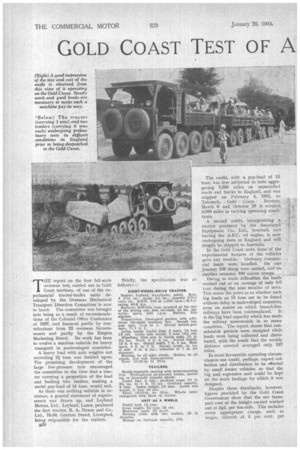GOLD COAST TEST OF A
Page 40

Page 41

If you've noticed an error in this article please click here to report it so we can fix it.
BRITISH 1 5-TONNER
THE report on the first full scale overseas test, carried out in Gold Coast territory, of one of the experimental tractor-trailer units developed by the Overseas Mechanical Transport Direction Committee' is now to hand. The committee was brought into being as a result of recommendations of the Colonial Office Conference of 1927, and financed partly by contributions from 23 overseas Governments and partly by the Empire Marketing Board. Its work has been to evolve a machine suitable for heavy transport in /undeveloped countries.
A heavy load with axle weights not exceeding 21 tons was decided upon. The promising development of the large low-pressure tyre encouraged the committee to the view that a tractor carrying a proportion of the load and hauling two trailers, making a useful pay-load of 15 tons, would suit.
As there was nothing suitable in existence, a general statement of requirements was drawn up. and Leyland Motors, Ltd., Leyland, Lanes, produced the first tractor, R. A. Dyson and Co., Ltd., 76-80, Grafton Street, Liverpool, being responsible for the trailers.
B30
The outfit, with a .pay-load of 15 tons, was first subjected to tests aggregating 5,560 miles. on unmetalled roads and tracks in England, and was shipped on February 3, 1933, to
Takoradi, Gold Coast. Between March 6 and October 28 it covered 8,050 miles in varying operating conditions. _
A second outfit, incorporating a tractor produced by the Associated Equipment Co., Ltd., Southall, and having the A.E.C. oil engine, is now undergoing tests in England and will shortly be shipped. to Australia.
In the Gold Coast tests, none of the experimental features of the vehicles gave any trouble. Ordinary commercial loads were handled. On one journey 150 sheep were carried, and 'on another occasion 100 native troops.
Owing to trade difficulties the loads worked out at an average of only 8.6 tons during the nine months of tests. This raises the point as to whether such big loads as 15 tons are to be found without delay in undeveloped countries, even on routes on which branch-line railways have been contemplated. It is the big load capacity which has made the railway uneconomic in so many countries. The report shows that considerable periods were occupied while loads were being collected and distributed, with the result that the weekly distance covered averaged only 237 miles.
In more favourable operating circumstances one could, perhaps, expect collection and distribution to be effected by. small feeder vehicles, so that the big and expensive unit could be kept on the main haulage for which it was designed. Despite these drawbacks, however, figures provided by the Gold Coast Government show that the net transport cost of the freight carried worked out at 54-11. per ton-mile. This includes every appropriate charge, such as wages, interest at 5 per cent, per
annum, depreciation on a five-year life or a mileage of 50,000, insurance, tax, spare parts and maintenance work, fuel at 2s. 9d. per gallcin, tyres, garaging and supervision. The report estimates that had an engine been fitted which used gas oil, the cost of which at Kumasi is 8d. per gallon, the transport cost, under the same conditions, would have been about 4icl. per ton-mile.
The unit was ferried across the Volta River, and the ease of handling resulted in the necessary manceuvring of the tractor and trailers on to the ferry being carried out without difficulty. The ascent of the Mampong Scarp, 30 miles north of Kumasi, averages 1 in 10 for four miles, and there is a continuous series of hairpin bends. Whether ascending or descending, the unit was kept under perfect control, even during the rains, the bends being negotiated easily owing to the correct tracking of the trailers. Other gradients up to 1 in 10 were satisfactorily negotiated.
A point is that it was found possible to operate regularly during the rainy season, often with full loads, including periods when it was impossible to run 2-ton four-wheeled lorries and light trailers. It is claimed that on dry earth the fully laden outfit will climb 1 in 8, and the tractor alone, with 3 tons payload, will negotiate 1 in 2. Mr. R. Nichols, chief transport officer in the Gold Coast, in his report dated December 5, states that he has recommended the Government to purchase the unit, which must now pay its way with one-way loads for the Government. He mentions certain disadvantages, including the excessive overall width of '7 ft. 4 ins., the maximum legal width for motor vehicles being 6 ft. 6 ins, and for :trailers 6 ft. The greater width limits regular employment with African drivers to a very few main roads.
Mr. Nichols also criticizes the high cost of fuel for a petrol engine, the inadequate area of the trailer brakes for regular use in his country and the rather " quick' action of the steering. With African drivers he would like to see the engine speed governed and the road speed limited to 15-16 m.p.h. He also suggests a lower unladen weight and platform levels for both tractor and trailers.
A more hopeful criticism, however, is that a redistribution of the unladen weight of the tractor might be made, so that, when required, it can be driven empty without overloading the universal joints and without reducing the controllability of the unit as a whole.




















































































